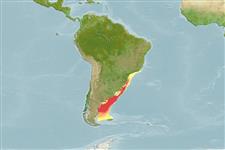Common names from other countries
Environment: milieu / climate zone / depth range / distribution range
Écologie
marin; saumâtre benthopélagique; profondeur 15 - 82 m (Ref. 127778). Subtropical; 13°S - 53°S, 67°W - 40°W
Southwest Atlantic: Brazil, Argentina, and Uruguay.
Length at first maturity / Taille / Poids / Âge
Maturity: Lm 29.0 range ? - ? cm
Max length : 60.0 cm TL mâle / non sexé; (Ref. 7392)
Description synthétique
Clés d'identification | Morphologie | Morphométrie
Épines dorsales (Total) : 13; Rayons mous dorsaux (Total) : 15; Épines anales: 3; Rayons mous anaux: 8.
Found on the continental shelf in colder waters. Utilized to some degree for human consumption.
Life cycle and mating behavior
Maturities | Reproduction | Spawnings | Egg(s) | Fecundities | Larves
Pereiro, S. and A. Vásquez, 1988. Peces marinos III. p. 65-94. In G.B. Cabal, B. Marcheti (eds.) Fauna Argentina: Peces. Centro Editor de América Latina S.A., Junin, Buenos Aires, Brazil, 102 p. (Ref. 7392)
Statut dans la liste rouge de l'IUCN (Ref. 130435)
CITES (Ref. 128078)
Not Evaluated
Menace pour l'homme
Harmless
Utilisations par l'homme
Can't connect to MySQL database (fbapp). Errorcode: Too many connections
